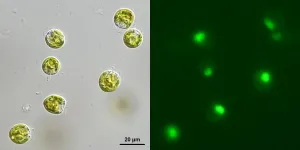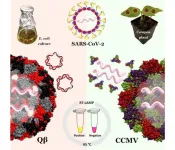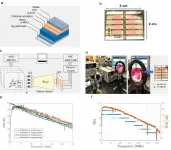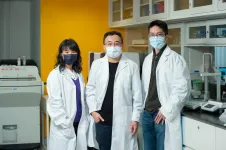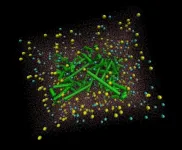(Press-News.org) Law enforcement seizures of drugs, particularly marijuana and methamphetamine, dropped at the beginning of the COVID-19 pandemic, then increased significantly in the following months--exceeding pre-pandemic seizure rates and providing clues about the impact of the crisis on substance use, according to a new study in the journal Drug and Alcohol Dependence.
The research was conducted as part of the National Drug Early Warning System (NDEWS), which uses real-time surveillance to detect early signals of potential drug epidemics. NDEWS is led by a team of researchers at the University of Florida, New York University, and Florida Atlantic University, and is funded by the National Institute on Drug Abuse, part of the National Institutes of Health.
Early research about how the pandemic has affected patterns of substance use has yielded mixed results. Some sources suggest that overall drug use has increased, while others point to a drop in use and availability of certain drugs. During the same period, multiple studies show an increase in overdoses.
Given conflicting information about changes in drug use, availability, and overdoses after the onset of the COVID-19 pandemic, NDEWS researchers examined trends in drug seizures recorded in the National High Intensity Drug Trafficking Area Program's Performance Management Process database to gain additional insight as to how the pandemic and its associated restrictions have shifted drug use.
"Although seizure data is not the most robust indicator of the prevalence of drug use, it does serve as an indicator of drug supply and availability," said study author Joseph Palamar, PhD, MPH, an associate professor of population health at NYU Grossman School of Medicine, an affiliated researcher with the Center for Drug Use and HIV/HCV Research (CDUHR) at NYU School of Global Public Health, NDEWS co-investigator and chair of the NDEWS Scientific Advisory Group. "For example, fewer seizures, or lower volumes of drugs seized, can reflect a disruption of drug supply chains."
The researchers looked at trends in 29,574 seizures of marijuana, cocaine, methamphetamine, heroin, and fentanyl within five geographic areas: Washington/Baltimore, Chicago, Ohio, New Mexico, and North Florida. They examined the number and total weight of seizures from March 2019, a year before the pandemic began in the U.S., through September 2020, six months into the pandemic.
They detected a sharp decrease in drug seizures--particularly marijuana and methamphetamine--in March and April 2020, when stay-at-home orders were put into place across the country. After reaching a low point in April, the number of seizures then increased through the remainder of the spring and summer when social distancing measures became more relaxed, peaking in August 2020. The weight of drugs seized by law enforcement also significantly increased after April, driven by an increase in volume of marijuana seizures.
Notably, the August peaks in the number and volume of seizures for marijuana and methamphetamine were higher than a year earlier. However, it is unknown whether the peaks represent greater availability of the drugs or whether law enforcement officials were merely "catching up" after several months of delayed seizures.
The researchers did not detect significant shifts in seizures involving cocaine, heroin, or fentanyl during the early months of the COVID-19 pandemic, although seizures involving fentanyl slowly increased in a stable manner over the two years independent of the pandemic.
The study authors noted that more research is warranted to determine the extent to which these seizures reflect changes in drug use. While decreases in seizures, for instance, likely indicate lower availability, it is also possible that fewer seizures may have indicated less drug law enforcement activity during the early months of the pandemic.
"Future research should harmonize data on seizures with other studies of drug use, availability, and overdoses in order to determine the most accurate picture of drug use trends during the pandemic," added Linda B. Cottler, PhD, MPH, FACE, of the University of Florida and principal investigator of NDEWS.
INFORMATION:
In addition to Palamar and Cottler, study authors include Austin Le of NYU and Thomas H. Carr of the University of Baltimore's Center for Drug Policy and Prevention and the Washington/Baltimore High Intensity Drug Trafficking Area Program. The research was supported by the National Institute on Drug Abuse (U01DA051126 and R01DA044207).
About CDUHR
The mission of the Center for Drug Use and HIV/HCV Research (CDUHR) is to end the HIV and HCV epidemics in drug using populations and their communities by conducting transdisciplinary research and disseminating its findings to inform programmatic, policy, and grass roots initiatives at the local, state, national, and global levels. CDUHR is a Core Center of Excellence funded by the National Institute on Drug Abuse (Grant #P30 DA011041). It is the first center for the socio-behavioral study of substance use and HIV in the United States and is located at the NYU School of Global Public Health. For more information, visit http://www.cduhr.org.
About NYU Langone Health
NYU Langone Health is a world-class, patient-centered, integrated academic medical center, known for its excellence in clinical care, research, and education. Included in the 260+ locations throughout the New York area are six inpatient locations: Tisch Hospital, its flagship acute-care facility in Manhattan; Rusk Rehabilitation, ranked as one of the top 10 rehabilitation programs in the country; NYU Langone Orthopedic Hospital, a dedicated inpatient orthopedic hospital in Manhattan with all musculoskeletal specialties ranked top 10 in the country; Hassenfeld Children's Hospital at NYU Langone, a comprehensive pediatric hospital, also in Manhattan, supporting a full array of children's health services; NYU Langone Hospital--Brooklyn, a full-service teaching hospital and level 1 trauma center located in Sunset Park, Brooklyn; and NYU Langone Hospital--Long Island, a full-service teaching hospital and level 1 trauma center located in Nassau County on Long Island. Also part of NYU Langone Health is the Laura and Isaac Perlmutter Cancer Center, a National Cancer Institute-designated comprehensive cancer center; NYU Grossman School of Medicine, which since 1841 has trained thousands of physicians and scientists who have helped to shape the course of medical history; and NYU Long Island School of Medicine. For more information, go to nyulangone.org, and interact with us on Facebook, Twitter, YouTube, and Instagram.
About NYU School of Global Public Health
At the NYU School of Global Public Health (NYU GPH), we are preparing the next generation of public health pioneers with the critical thinking skills, acumen, and entrepreneurial approaches necessary to reinvent the public health paradigm. Devoted to employing a nontraditional, interdisciplinary model, NYU GPH aims to improve health worldwide through a unique blend of global public health studies, research, and practice. The School is located in the heart of New York City and extends to NYU's global network on six continents. Innovation is at the core of our ambitious approach, thinking and teaching. For more, visit: http://publichealth.nyu.edu/
While natural disasters and economic recessions traditionally unleash an uptick in child abuse, a new study suggests that cases may have declined in the first months of the pandemic, compared with the same timeframe in previous years.
In the study, led by UCSF Benioff Children's Hospitals and Children's Mercy Kansas City, researchers tracked the number of pediatric inpatients ages 5 and under in 52 children's hospitals nationwide for the first eight months of 2020. They found a steep decline in the number of ER visits and hospital admissions, including those requiring treatment for physical abuse. This started in mid-March - around the time some states issued shelter-in-place ...
A Ludwig-Maximilians-Universitaet (LMU) in Munich team has shown that slight alterations in transfer-RNA molecules (tRNAs) allow them to self-assemble into a functional unit that can replicate information exponentially. tRNAs are key elements in the evolution of early life-forms.
Life as we know it is based on a complex network of interactions, which take place at microscopic scales in biological cells, and involve thousands of distinct molecular species. In our bodies, one fundamental process is repeated countless times every day. In an operation known as replication, proteins duplicate the genetic ...
New research suggests that the ability of green algae to eat bacteria is likely much more widespread than previously thought, a finding that could be crucial to environmental and climate science. The work, led by scientists at the American Museum of Natural History, Columbia University, and the University of Arizona, found that five strains of single-celled green algae consume bacteria when they are "hungry," and only when those bacteria are alive. The study is published today in The ISME Journal.
"Traditionally, we think of green algae as being purely photosynthetic organisms, producing their food by soaking in sunlight," said Eunsoo Kim, an associate curator at the American Museum of Natural History and one of the study's corresponding ...
An international team led by Prof. dr habil. Andrzej Niedzielski, an astronomer from the Nicolaus Copernicus University in Torun (Poland), has discovered yet another three extrasolar planets. These planets revolve around the stars that can be called elder sisters of our Sun.
You can read about the astronomers' success in Astronomy and Astrophysics. The prestigious European journal will publish the paper: Tracking Advanced Planetary Systems (TAPAS) with HARPS-N. VII. Elder suns with low-mass companions. Apart from Prof. Andrzej Niedzielski from the NCU Institute of Astronomy, the team which worked on the discovery includes Prof. dr habil. Gracjan Maciejewski, also from the NCU Faculty of Physics, Astronomy and Informatics, Prof. Aleksander Wolszczan (Pennsylvania State ...
For several years now, the biofuels that power cars, jet airplanes, ships and big trucks have come primarily from corn and other mass-produced farm crops. Researchers at USC, though, have looked to the ocean for what could be an even better biofuel crop: seaweed.
Scientists at the USC Wrigley Institute for Environmental Studies on Santa Catalina Island, working with private industry, report that a new aquaculture technique on the California coast dramatically increases kelp growth, yielding four times more biomass than natural processes. The technique employs a contraption called the "kelp elevator" ...
Australia's marine World Heritage Sites are among the world's largest stores of carbon dioxide according to a new report from the United Nations, co-authored by an ECU marine science expert.
The UNESCO report found Australia's six marine World Heritage Sites hold 40 per cent of the estimated 5 billion tons of carbon dioxide stored in mangrove, seagrass and tidal marsh ecosystems within UNESCO sites.
The report quantifies the enormous amounts of so-called blue carbon absorbed and stored by those ecosystems across the world's 50 UNESCO marine World Heritage Sites.
Despite covering less ...
Rapid COVID-19 tests are on the rise to deliver results faster to more people, and scientists need an easy, foolproof way to know that these tests work correctly and the results can be trusted. Nanoparticles that pass detection as the novel coronavirus could be just the ticket.
Such coronavirus-like nanoparticles, developed by nanoengineers at the University of California San Diego, would serve as something called a positive control for COVID-19 tests. Positive controls are samples that always test positive. They are run and analyzed right alongside patient samples to verify that COVID-19 tests are working consistently and as intended.
The positive controls developed at UC San Diego offer several advantages over the ones currently used in COVID-19 testing: ...
Around the world there are currently more than 18 billion internet-connected mobile devices. In the next 10 years, anticipated growth in the Internet of Things (IoT) and in machine-type communication in general, will lead to a world of hundreds of billions of data-connected objects. Such growth poses two very challenging problems:
How can we securely connect so many wireless devices to the Internet when the radio-frequency bandwidth has already become very scarce?
How can all these devices be powered?
Regular, manual charging of all mobile Internet-connected devices will not be feasible, and connection to ...
A Hong Kong Baptist University-led (HKBU) research team has developed a novel drug which has the potential to become a next-generation treatment for cancers associated with Epstein-Barr virus (EBV).
The peptide-linked drug, which is responsive to the acidic environment found in tumours, is the first known agent to have successfully targeted two viral proteins that are simultaneously produced by EBV. It also offers a new strategy by increasing the uptake of anti-cancer drugs in tumour cells, thus allowing the application of lower drug dosages which helps reduce treatment side effects and health risks.
The research results were published in the international academic journal Advanced Science.
New drug targets ...
Modern electronics is approaching the limit of its capabilities, which are determined by the fundamental laws of physics. Therefore, the use of classical materials, for example, silicon, is no longer able to meet the requirements for energy efficiency of the devices. Currently, it is necessary to start searching for new materials, new principles of electronic devices' functioning. To solve this problem, researchers of Peter the Great St.Petersburg Polytechnic University (SPbPU) are developing thin films, the elements for biomolecular electronics. Scientists believe that biological macromolecules such as nucleic acids, proteins, amino acids can become a promising material for modern ...
